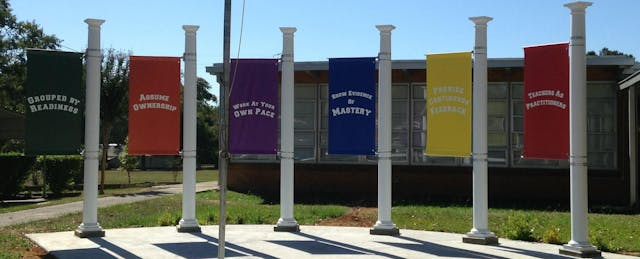For children who can stomach school through twelfth grade, the experience culminates with a walk across the graduating stage, and in far too many cases, we place in their hands a diploma not worth the cheap paper it’s printed on. This is the reality of my ever-abiding frustration with our outdated model of public schooling.
Far too many policy makers, elected officials and “educrats,” my term for educators who are hellbent on maintaining the status quo, protect this antiquated, broken and egregiously dysfunctional system with life and limb. An overwhelming majority of America’s public schools continually perform at the bottom of the totem pole when compared to their international counterparts in science and mathematics; we have come a full 64 years after the Brown vs. Board of Education decision and we see in glaring fashion the return of separate and unequal public schooling.
In spite of these and other shameful realities, the demand of state assessments continue to rule the day, foregoing the warning from business and leadership author Steve Denning in his Forbes column back in 2011: “The current focus on testing has tended to make test results the goal of the system, rather than a measure...Using tests as the goal infringes Goodhart’s law: when measure becomes the goal, it ceases to be an effective measure.”
In July 2013 by a unanimous vote, the Board of Trustees for McComb School District in Mississippi appointed me as superintendent of schools. My appointment came at a time when 77 percent of McComb’s kindergarteners had not met the required performance on the state’s kindergarten readiness assessment. This was a strong indication that the majority of our kindergarteners would begin their school experience lacking the skills needed for success during their formative years, which meant there was a low likelihood that these students would be reading on grade level by the end of third grade. For many years, the district achieved only incremental progress in academic achievement as measured by Mississippi’s Accountability System, with approximately 80 percent of students in grades 3-12 consistently failing to score proficient or above on state assessments.
As the new superintendent, I recognized that there were many good things happening in the district for which the community could be justifiably proud. However, I had to take full responsibility for a very basic and fundamental truth—our school district, as it was currently designed and operating, wasn’t meeting the needs of our modern learners. This was my struggle.
How could we transform a traditional, dysfunctional, low-performing system measured by high-stakes assessments into a system with exceptional teaching and learning environments that developed students empowered to change the world? We couldn’t wait for a miracle, we needed to make one. But figuring out how to operate a district within a dual system, staying true to our state’s accountability model and meeting the needs of our learners hasn’t been easy.
I was well aware that any attempt to force broad-based radical change onto the school board and community would be futile and not in my professional best interest. To do so would assure a short-lived tenure as McComb’s superintendent. I would be happy to drive the nail into the coffin of traditional public schooling but couldn’t be viewed as the culprit that caused its demise. I knew the change needed to come from the community. My staff and I gathered a diverse cadre of community members including business and industry representatives, parents, students, teachers, administrators, law enforcement officials and clergy to develop an innovative five-year strategic plan designed to make the case for change.
After weeks of conversation, the group presented me with their suggestions to change our broken system. They wanted student-centered teaching and learning environments where success would be determined by growth rather than state assessment proficiency or seat time. They wanted a system where teachers could meet the needs of every individual child. While this desire by no means exempted the district from state accountability, we now had a strong community force driven to make change.
The recommendations were accepted. Traditional public schooling was dead in McComb and I was free of blame. My staff and I knew that to be successful, our transition to student-centered learning environments would require extensive planning so we took a year to think through our change process. We moved forward with deliberate speed and made sure to keep the community involved.
Four Steps We Took to Catalyze Change
In January 2015, we began to implement our multi-step plan, prioritizing the roll out of some bold changes in our schools. The roll out began with one pilot school with a plan to expand to all schools across the district by 2020.

Prioritizing Mastery over Seat Time
Our district’s student-centered teaching and learning model allows learners the time and resources needed to achieve learning targets and progress through their school experience by mastering content rather than clocking seat time. They assume responsibility for their learning and work with teachers to plan, set goals and provide evidence of what they know and can do based on demonstrated performance. What can this evidence look like in practice? One of our first graders created an adjective bingo game to demonstrate mastery of adjectives, a second grader developed an iMovie depicting the history of Mississippi and a fourth grader showed evidence of understanding a math concept using the coding program ScratchJr.
Tailored Professional Development
Students aren’t the only ones who deserve learning experiences specifically designed to meet their needs. Teachers also need targeted support to bring change to their practice. We now use Accelerate Education, a platform that gives our teachers unprecedented access to high-quality curricular resources aligned to state and national standards. A variety of content and professional development is tailored to meet individual needs of teachers and there are opportunities to obtain microcredentials.
Trading in Grades for Instructional Levels
Our instructional model shifted from “one-size fits all” to a more personalized approach, providing each learner with an Individualized Success Plan, a document that includes suggested learning objectives (SLOs) based upon the student’s unique needs. In August 2015, we began making changes to the grading practices at our pilot school, Summit Elementary School, which serves as a prototype for other school in the district. At Summit Elementary, traditional grade levels have been eliminated and replaced with instructional levels. Now, report cards reflect progress on grade level content as well as progress toward meeting the standards specified in their Individualized Success Plan.
A New Lens for Data
Students learning at grade level are expected to score minimally proficient on state assessments, but that’s not always how it works. The goal we are prioritizing is for every learner to experience a year and half to two years of growth. This provide students who are not at grade level an opportunity to fill proficiency gaps allowing them to meet grade level proficiency sooner rather than later or never.
Historically, our state assessment results were provided to the community and school board through traditional formatting—a set of raw scores and percentages with a slew of breakdown possibilities. Now, we also provide growth data so we can visualize progress for all students, regardless of whether they achieve proficiency or not.
Over the past two years, we’ve experienced positive change in the confidence levels of our children, enthusiasm of our teachers, pride of our parents and most of all, tangible academic growth of students. While there’s much work to be done, we’re fully confident the district is on its way toward developing students with the potential to change the world.


